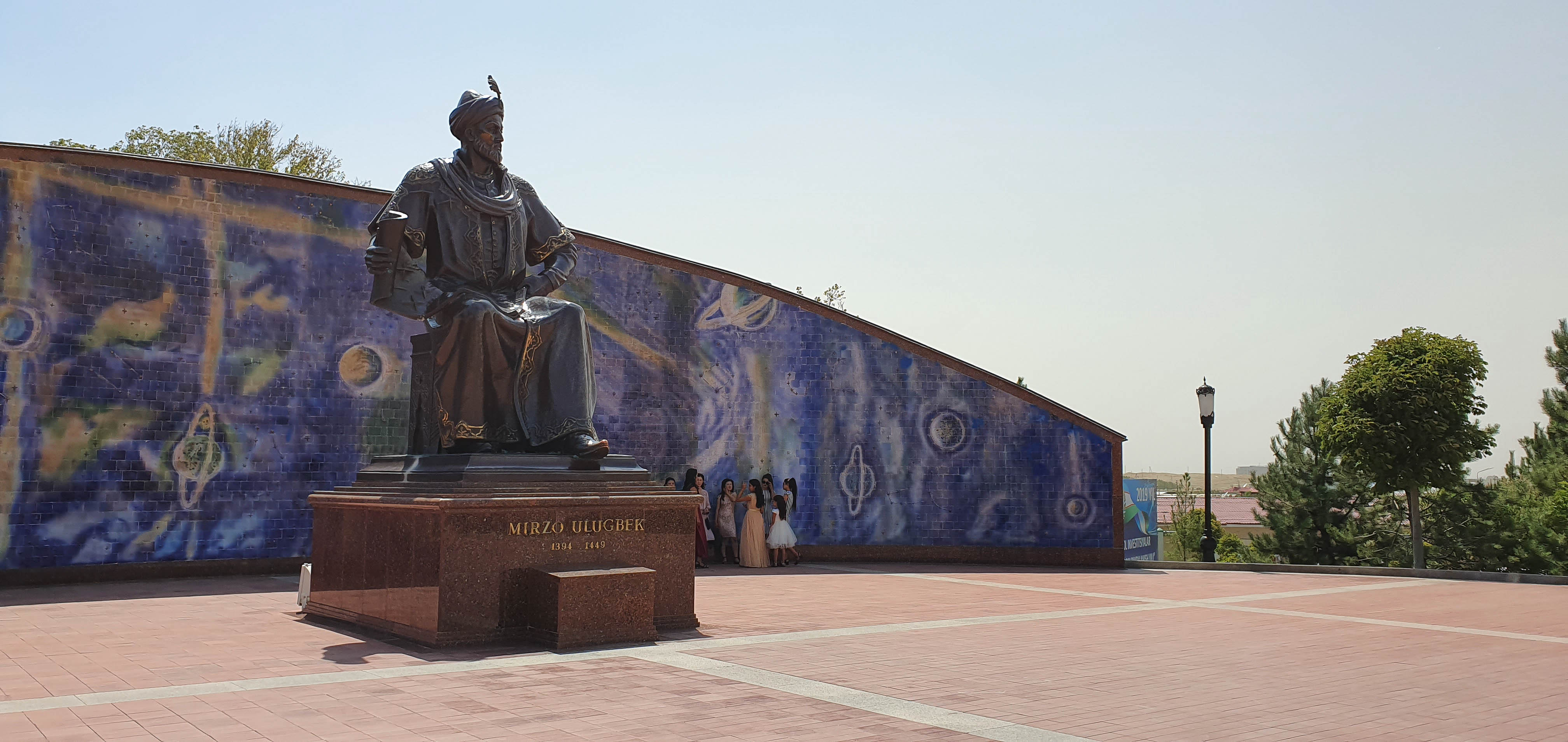25 Nov Samarkand – city guide
Here in historical Samarkand was where I really fell in love with Uzbekistan. Silk Road culture, beautiful architecture and wonderful chance encounters made this a city I will remember fondly forever.
Number one must see is Registan Square. This complex is one of the reasons Samarkand has UNESCO World Heritage status. Registan translates as ‘sandy place’ which is what the square was, a centre for city social life, trade, public proclamations and executions. Today it is bordered on three sides by madrasahs which were completed in 1420. The decorative tile work is incredible, each arch differing to the next with unique geometric patterns, stars and even tigers. What were originally lecture rooms and student dormitories have been transformed into small shops and businesses selling local products and souvenirs. We hugely lucked out as we happened to be in Samarkand during rehearsals for Sharq Taronalari – one of the largest Central Asian music festivals in the world! It was three weeks before the actual festival and they were already doing full run through rehearsals. Preparation central! As this only occurs every two years it was such a fluke that we were able to see part of it. The dancing, singers, huge live band were incredible, we got mesmerised and could not leave which is saying something because we were on our way to dinner when we came across it! If you’re planning to be in Samarkand during a Sharq Taronalari year make sure to time your visit accordingly.
Uzbeks love a mausoleum and the Shah-i-Zinda is the ultimate. Almost every surface is covered in turquoise which is both beautiful and cooling in a desert environment. There is a deeper underlying meaning behind this as blue is the colour of the heart and one of the Uzbek colours of grief. In many traditional families women wear blue for a year after a relative’s death. This ornate ensemble of tombs stretches down an avenue which grew to more than twenty buildings between the 11th and 19th centuries. Relatives of the leader Amir Timur are buried here, some with fantastic golden domed ceilings and intricately carved wooden doors. I’d avoid taking a guided tour no matter how friendly and helpful they seem as you are likely to get ripped off when settling the fee at the end. Like the Registan, you will leave Shah-i-Zinda with a feeling of awe and respect for such a historical site.
The Observatory of Ulugbek was a fun bit of exploration. We decided to walk there from Shah-i-Zinda, a half hour walk which would be best done early in the morning as the August heat can be a bit much later in the day. I tell you this in hindsight as we did the walk in nearly the hottest part of the day and there wasn’t much shade ?There’s a good view from the observatory and you can see part of the original trench with the meridian arc. If you enjoy astronomy and mathematics you’ll appreciate the museum celebrating Ulugbek’s work, plus there is a huge statue of him which makes for a good photo opportunity.
After your walk and intellectual stimulation you will need food. Handy then that Domashnii Restaurant is round the corner from the Observatory. This small family restaurant has a lovely courtyard seating area, perfect for lounging with a cold drink and fresh watermelons. Classic Uzbek food is served here from shashlik (grilled meat) to plov, as well as bread and kaymak. We had a small bowl of beef stew with vegetables, perfect comfort food.
I had one of the weirdest hotdogs in my life in Samarkand. We were craving some naughty fast food and this hot dog and ice cream restaurant seemed to be popular every night so we thought it would be worth a go. My extremely basic Russian was struggling to communicate effectively but fortunately a lovely student with perfect English helped me out. Him and his friend asked us to join them at their table and we had a great chat about university, future plans and life in Samarkand. I’ve never come across friendliness and hospitality like it anywhere else. Apparently it’s part of Uzbek culture to ‘treat guests better than you treat your father’ ie. make everyone feel at home and as if they are family. What wonderful values. Back to the hot dog ? It was less roll, more wrap with contents gone berserk. Coleslaw, sausage, ham, cheese, mayonnaise, chips were all squished inside! Definitely an overload but our chance encounter made it worthwhile.
It wouldn’t be a munchtime holiday without a good market. Siab Bazaar is a bustling farmers market where you’ll find more types of raisin than you can imagine. Pyramids of melons become a familiar sight in Uzbekistan, as do the carefully placed displays of figs, plums, tomatoes and other fresh fruits. Dried fruits are extremely popular, with greater varieties than we can find in the UK. Similarly, nuts are fresher – try to buy them loose as they’re less likely to have been sitting around too long. Market vendors are happy for you to taste their produce, don’t feel like you have to buy it afterwards as they really don’t mind. I loved trying different types of raisin – we’re so used to a bog standard raisin in the UK that this was a revelation! Ditto fresh walnuts – so much flavour.
Next to the market is Kyzyl Chaixona. This ‘red teahouse’ has traditional outdoor seating overlooking the market – perfect for tired feet after a good grocery shop! The waitress speaks some English which is perfect as there is no menu. We asked for a beef noodle soup called laghman. Served with the ever present fresh bread which accompanies every meal in Uzbekistan, these noodles are a treat. They are like udon noodles in thickness which work perfectly in the rich beef and veg stock. Soft chunks of beef sit alongside their worldwide companions: carrots, onions and potatoes. It’s finished with fresh dill and is one of my stand out meals not only from Samarkand but our entire holiday.
On our final evening we decided to visit Hovrenko Wine Factory. Mr Munch found out about the wine tasting on Trip Advisor and we thought it sounded fun. Knowing nothing about Uzbek wine, it’s the ideal place to learn more and the whole experience could not have been easier. Our guide picked us up from our hotel and drove us across town to the winery. On booking you choose which language you speak and they provide a guide accordingly. She was absolutely lovely and gave us a tour of the museum with stories of the various owners who shaped the winery over the years. We were shown into a large dining room with scenes of farm and vineyard life painted across the walls. A large group of tipsy Korean ladies were just leaving, clinking bottle bags in hand. During the tasting we discovered that Uzbek wine leans heavily on the sweet side, with a specialism in dessert wines. Three of these ended up coming home with us – the strongest of which is incredibly unique with an almost herbal quality. Make sure you line your stomach as some of these are pretty strong and as we were half jokingly told ‘you must finish the glass before we move on or we will throw you out’! ?If you’re not a fan of sweet wine you might not enjoy this, however it was a great opportunity to learn about Uzbekistan’s wine culture and one I would highly recommend.
Two more historical sites to finish with. Firstly, the Bibi-Khanym Mausoleum and mosque. While this is one of the smaller complexes it is a great example of 14th century architecture. At that time this was one of the most impressive mosques in the Islamic world. Since then, earthquakes have collapsed part of the structure but you can imagine how magnificent it would have looked. The 50m high turquoise domed minarets act as a landmark for miles around. We visited at night and were the only people there – you can get some great photos when it’s lit up.
The Gur-e Amir Complex is similar in that it was in a state of disrepair for a few centuries when Samarkand was in decline. Persian for ‘Tomb of the King’, this is the resting place of Asian conqueror Timur, his sons and grandsons (including Observatory Ulugbek). As you can see in my photos, the gold ceiling is blingtastic – light reflects off every surface to give a wonderful warm glow.
TRAVEL
Our journey from Tashkent to Samarkand was by train. The best way to get your tickets is in advance through a reputable company to avoid fraud and overpaying. We used Advantour, a company dealing in Silk Road private tours and travel services. One of their travel consultants booked our train journeys and delivered the tickets straight to our hotel for collection on arrival. Communication was excellent and done in English. Fantastic service overall. Well worth a bit of forward planning to make everything run smoothly on the day.
If you made it to the end of this post thanks so much for reading it! I hope you enjoyed my little insight into this culturally rich city. Our final stop is Bukhara where I end up bouncing small children on my lap in a packed minibus on the way home from a thousand year old cemetery and we find the craziest wasps I’ve ever seen. Stay tuned for more and there’s also my Instagram for more travel and food excitement. Until next time!
???












No Comments